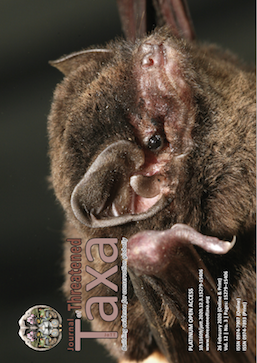Gynochthodes cochinchinensis (DC.) Razafim. & B. Bremer (Morindeae: Rubioideae: Rubiaceae): an addition to the woody climbers of India
Main Article Content
Abstract
Gynochthodes cochinchinensis (Rubiaceae), a woody climber, is reported here as a new addition to Indian flora from Similipal Biosphere Reserve, Odisha. The species resembles its closely allied taxon Gynochthodes umbellata, but can be distinguished from it by a number of distinct morphological characters. A detailed description, notes on habitat, ecology and distribution are provided in this paper with color photographs for easy identification.
Article Details
Authors own the copyright to the articles published in JoTT. This is indicated explicitly in each publication. The authors grant permission to the publisher Wildlife Information Liaison Development (WILD) Society to publish the article in the Journal of Threatened Taxa. The authors recognize WILD as the original publisher, and to sell hard copies of the Journal and article to any buyer. JoTT is registered under the Creative Commons Attribution 4.0 International License (CC BY), which allows authors to retain copyright ownership. Under this license the authors allow anyone to download, cite, use the data, modify, reprint, copy and distribute provided the authors and source of publication are credited through appropriate citations (e.g., Son et al. (2016). Bats (Mammalia: Chiroptera) of the southeastern Truong Son Mountains, Quang Ngai Province, Vietnam. Journal of Threatened Taxa 8(7): 8953–8969. https://doi.org/10.11609/jott.2785.8.7.8953-8969). Users of the data do not require specific permission from the authors or the publisher.
References
Blume, C.L. (1827). Gynochthodes. In: Bijdragen tot de flora van Nederlandsch Indie. 16: 993.
Bremer, B. (2009). A review of molecular phylogenetic studies of Rubiaceae. Annals of the Missouri Botanical Garden 96(1): 4–26. https://doi.org/10.3417/2006197 DOI: https://doi.org/10.3417/2006197
Bremer, B. & J.F. Manen (2000). Phylogeny and classification of the subfamily Rubioideae (Rubiaceae). Plant Systematics and Evolution 225(1–4): 43–72. https://doi.org/10.1007/bf00985458 DOI: https://doi.org/10.1007/BF00985458
Bremer, B. & T. Eriksson (2009). Time tree of Rubiaceae; Phylogeny and dating the family, subfamilies and tribes. International Journal of Plant Sciences 170(6): 766–793. https://doi.org/10.1086/599077 DOI: https://doi.org/10.1086/599077
Davis, A.P., R. Govaerts, D.M. Bridson, M. Ruhsam, J. Moat & N.A. Brummitt (2009). A global assessment of distribution, diversity, endemism, and taxonomic effort in the Rubiaceae. Annals of the Missouri Botanical Garden 96: 68–78.
De Candolle, A.P. (1830). Prodromus systematis naturalis regni vegetabilis. Pars IV: 449. Sumptibus Sociorum Treuttel & Wurtz, Paris. https://doi.org/10.5962/bhl.title.286 DOI: https://doi.org/10.5962/bhl.title.286
Johansson, J.T. (1987). Pollen morphology of the tribe Morindeae (Rubiaceae). Grana 26: 134–150.
Loureiro, J.de (1790). Flora cochinchinensis: sistens plantas in regno Cochinchina nascentes. Volume I: 140. Ulyssipone, Lisbon. https://doi.org/10.5962/bhl.title.560 DOI: https://doi.org/10.5962/bhl.title.560
Mabberley, D.J. (2017). Mabberley’s Plant-Book: A portable dictionary of plants, their classification and uses. 4th edition. Cambridge Univ. Press. Cambridge. DOI: https://doi.org/10.1017/9781316335581
Razafimandimbison, S.G., C. Rydin & B. Bremer (2008). Evolution and trends in the psychotrieae alliance (Rubiaceae)—A rarely reported evolutionary change of many-seeded carpels from one-seeded carpels. Molecular Phylogenetics and Evolution 48: 207–223. https://doi.10.1016/j.ympev.2008.03.034 DOI: https://doi.org/10.1016/j.ympev.2008.03.034
Razafimandimbison, S.G., T.D. McDowell, D.A. Halford & B. Bremer (2009). Molecular phylogenetics and generic assessment in the tribe Morindeae (Rubiaceae-Rubioideae): How to circumscribe Morinda L. to be monophyletic? Molecular Phylogenetics and Evolution 52(3): 879–886. https://doi.10.1016/j.ympev.2009.04.007 DOI: https://doi.org/10.1016/j.ympev.2009.04.007
Razafimandimbison, S.G. & B. Bremer (2011). Nomenclatural changes and taxonomic notes in the tribe Morindeae (Rubiaceae). Adansonia (sér. 3) 33(2): 283–309. https://doi.10.5252/a2011n2a13 DOI: https://doi.org/10.5252/a2011n2a13
Robbrecht, E. (1988). Tropical Woody Rubiaceae. Opera Botanica Belgica 1: 1–271.
Suratman (2018). The genus Gynochthodes (Rubiaceae) in Sumatra. Blumea 62: 230–239. https://doi.org/10.3767/blumea.2018.62.03.05 DOI: https://doi.org/10.3767/blumea.2018.62.03.05

